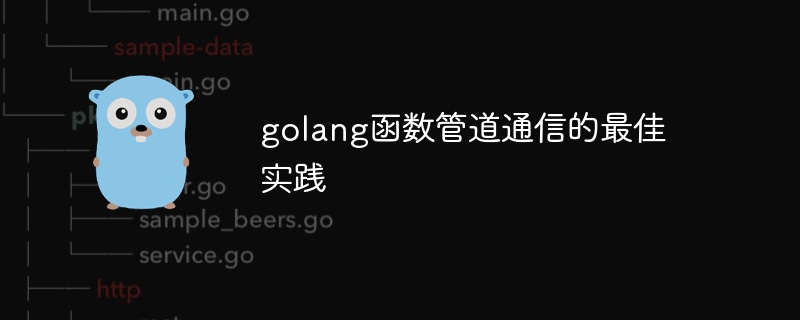
The best practice is: use buffered pipes to avoid coroutine blocking. Limit pipeline concurrency to prevent deadlock. Close the sender end of the pipe and notify the receiver. Use one-way pipes to prevent unsafe access. Pipe multiple receivers to implement fan-out operations.

Best Practices for Pipeline Communication in Go
Pipelines are used in Go for secure communication between concurrent program components. A kind of channel. Pipes provide a lock-free mechanism that allows coroutines to send and receive values without locking.
Best Practices:
Use buffered pipes: Buffered pipes allow multiple values to be stored simultaneously, thus Avoid coroutine blocking.
// 创建一个有缓冲大小为 10 的管道 bufferedChan := make(chan int, 10)
Limit pipe concurrency: Using non-buffered pipes or limiting the buffer size can prevent coroutines from over-consuming pipes, leading to deadlocks.
// 创建一个非缓冲管道 unbufferedChan := make(chan int)
Close the sender end of the pipe: After the sender has finished sending values to the pipe, the sender end of the pipe should be closed to notify the receiver.
close(chan)
Use one-way pipes: One-way pipes can only be used to send or receive values, which prevents unsafe concurrent access.
input := make(chan<- int) // 只发送管道 output := make(<-chan int) // 只接收管道
Use pipes for multiple receivers: Pipes can be received by multiple receivers at the same time, which can achieve fan-out operations.
// 从 c1 和 c2 合并数据,分别使用两个协程接收数据
func merge(c1, c2 <-chan int) <-chan int {
out := make(chan int)
go func() {
for v := range c1 {
out <- v
}
close(out)
}()
go func() {
for v := range c2 {
out <- v
}
close(out)
}()
return out
}Practical case:
In a scenario that requires processing a large amount of data, pipelines can be used to process data in parallel.
// 并行处理数据
func processData(data []int) []int {
result := make(chan int) // 用于收集结果
// 创建多个协程并行处理数据
for _, num := range data {
go func(num int) {
result <- processSingle(num) // 单个协程处理数据
}(num)
}
// 从管道中收集结果
processedData := make([]int, 0, len(data))
for i := 0; i < len(data); i++ {
processedData = append(processedData, <-result)
}
return processedData
}By using pipelines, the processing tasks of large amounts of data can be distributed to multiple coroutines, thereby improving the efficiency of the program.
The above is the detailed content of Best practices for golang function pipeline communication. For more information, please follow other related articles on the PHP Chinese website!
 How to define variables in golang
How to define variables in golang
 What are the data conversion methods in golang?
What are the data conversion methods in golang?
 What are the commonly used libraries in golang?
What are the commonly used libraries in golang?
 What is the difference between golang and python
What is the difference between golang and python
 What's the matter with Douyin crashing?
What's the matter with Douyin crashing?
 What should I do if my computer won't turn on?
What should I do if my computer won't turn on?
 Registration-free CDN acceleration service
Registration-free CDN acceleration service
 How to use python for loop
How to use python for loop




